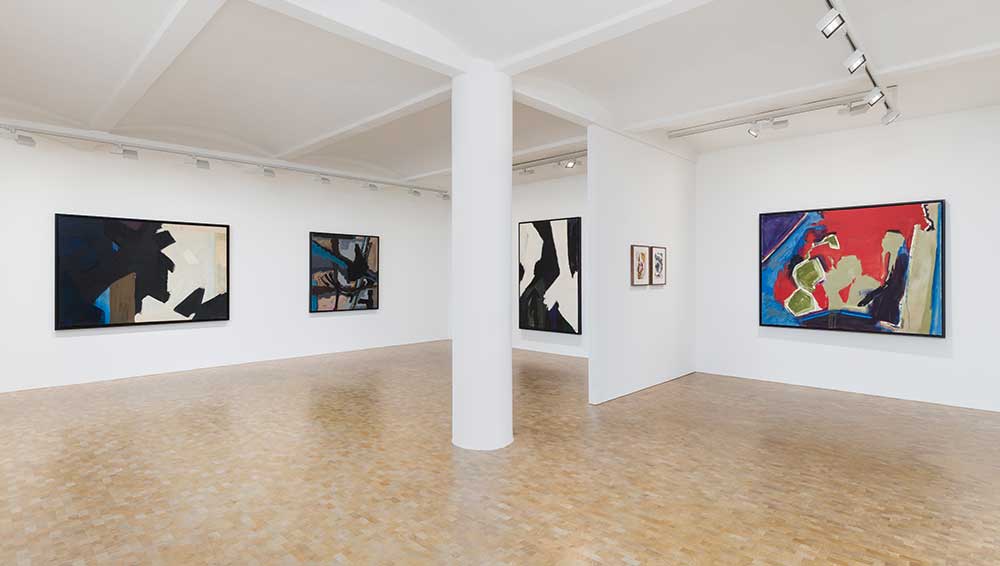
Judith Godwin, Expressions of Life, 2024, installation view, Pippy Houldsworth Gallery, London. Courtesy Pippy Houldsworth Gallery, London. Photo; Mark Blower.
Pippy Houldsworth Gallery, London
26 January – 9 March 2024
by BETH WILLIAMSON
It is difficult to believe that this is the first European solo exhibition of the work of the American painter Judith Godwin (1930-2021). Age 91 when she died, it is only in recent years that Godwin’s painting has come to be more widely appreciated following its inclusion in group exhibitions such as Action, Gesture, Paint at the Whitechapel Gallery in London in 2023 and Women of Abstract Expressionism at the Denver Art Museum in 2016. Now, the exhibition at Pippy Houldsworth Gallery in London, a tiny show with just 12 or so works, spans the extent of Godwin’s work, albeit in a small way, from the early 1950s, when she associated with the abstract expressionists, until the end of the 20th century.
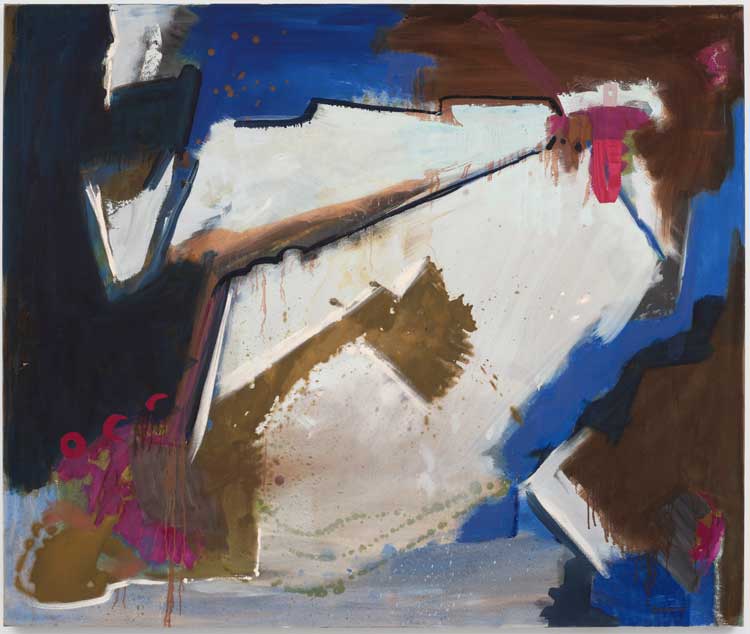
Judith Godwin. Planes, 1991. Oil on canvas with collaged fabric, 132.1 x 157.5 cm (52 x 62 in). Courtesy Pippy Houldsworth Gallery, London, and Berry Campbell, New York. © Judith Godwin Foundation. Photo: Ben Westoby.
Godwin regarded painting as “an act of freedom and a realisation that images generated by the female experience can be a powerful and creative expression for all humanity”. Therefore, despite the macho bravado generally associated with abstract expressionist painters such as Jackson Pollock, Willem de Kooning and others, Godwin was determined to forge her own path through such machismo in order to find a more nuanced consideration to the energetic gestures of this approach. Her intention was always to be true to herself, recognising the need to “emphasise what is important by painting the image of my feelings on canvas – to accept my feelings honestly, and not falsify”.
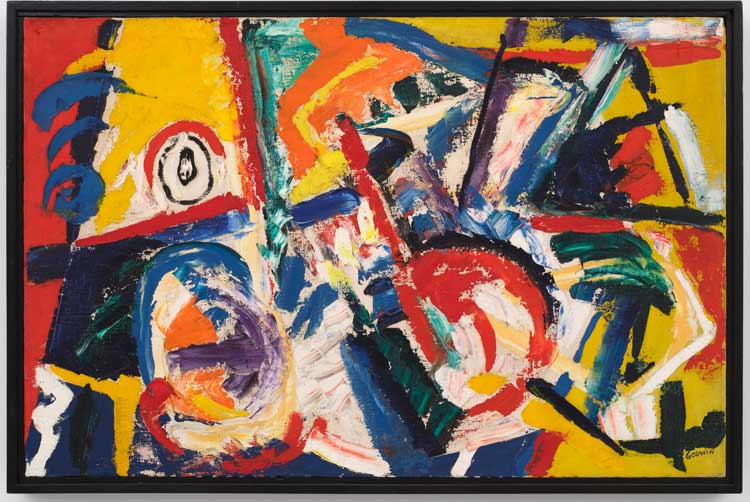
Judith Godwin. Provincetown Summer, 1953. Oil on canvas, 63.2 x 96.2 cm (25 x 38 in). Courtesy Pippy Houldsworth Gallery, London, and Berry Campbell, New York. © Judith Godwin Foundation. Photo: Ben Westoby.
Born in Suffolk, Virginia, Godwin trained initially at Mary Baldwin College (now Mary Baldwin University). A move to New York led her to the Art Students League and to studies with the German-born American Hans Hofmann, influential for abstract expressionism, in New York and Provincetown, Massachusetts. Provincetown, a small Cape Cod town, was full of artists drawn there for the summer by Hofmann’s teaching. The atmosphere and opportunities that opened up to young artists is explored in early movies by the artist, teacher and film-maker Yvonne Andersen. It is explored, too, in Godwin’s painting Provincetown Summer (1953), one of the boldest images in this exhibition, filled with colour, energy and the joys of summer.
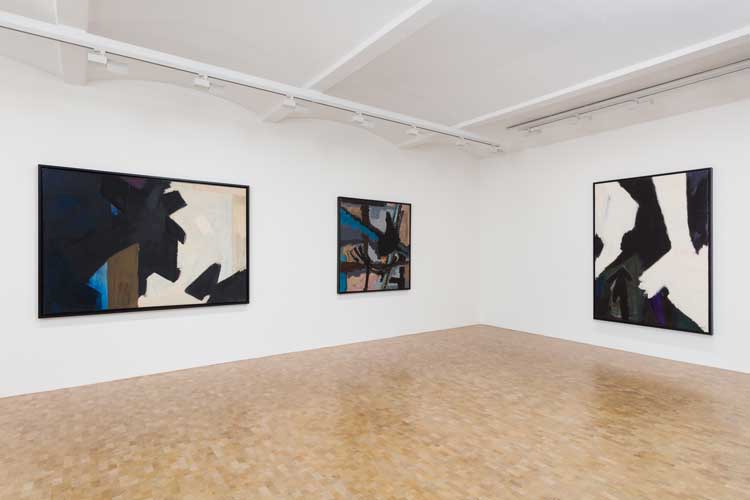
Judith Godwin, Expressions of Life, 2024, installation view, Pippy Houldsworth Gallery, London. Courtesy Pippy Houldsworth Gallery, London. Photo; Mark Blower.
Other work from the 1950s represented in this exhibition includes Series 5, No 5 (1955) and Untitled (1958), both of which adopt a much more sombre tone than the Provincetown painting. Godwin’s lyrical style and jagged passages in these two works invoke a much darker aesthetic than the Provincetown painting with its hints of Pollock’s Summertime: Number 9A (1948), in palette, tone and energy at least. In her works of the later 50s, Godwin sets irregular planes of colour against one another so that opposing forces are balanced in compositions that have more in common with Hofmann’s work than they do with Pollock’s. The internal energy created by the juxtapositions she sets up create a lexicon of sensations. Forms are opened or closed, dark or light, and appear in movement, or at rest. She underlined her abstract expressionist credentials by taking a stronger, harsher approach saying: “If you were a [woman] painter … you had to paint as strongly, as violently as the men did.” The jagged aggressive angles in these paintings certainly precipitate a violent energy that is at odds with the lyrical approach she took elsewhere.
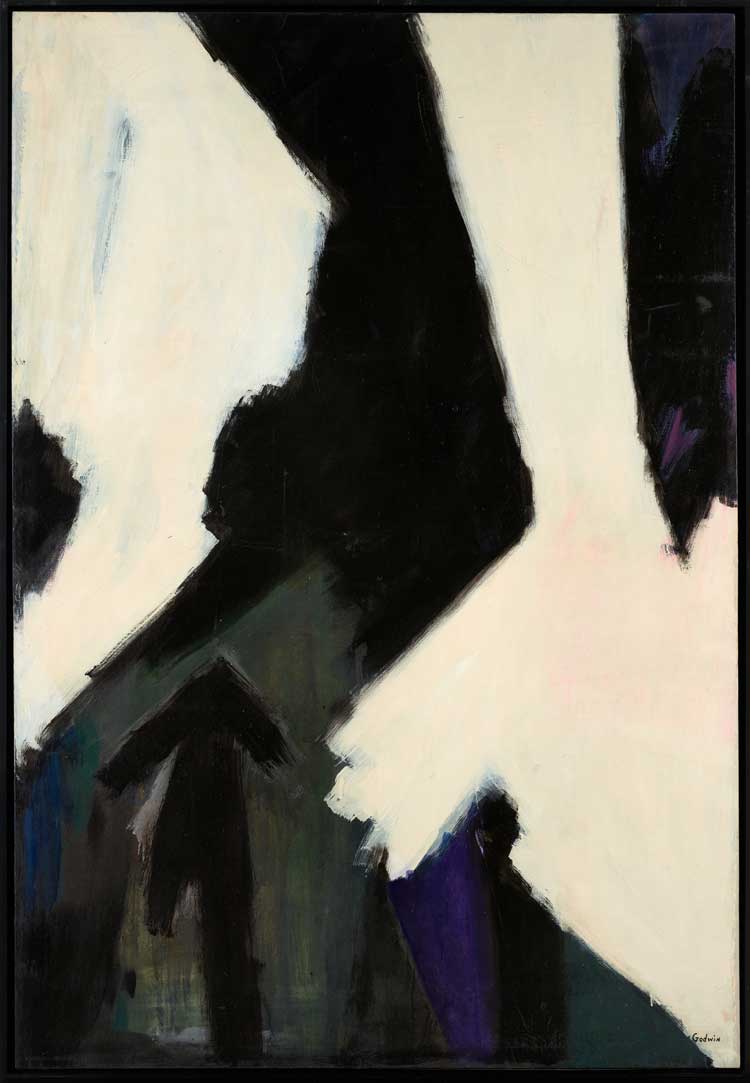
Judith Godwin. Untitled, 1958. Oil on linen, 182.9 x 125.1 cm (72 x 49 ½ in). Courtesy Pippy Houldsworth Gallery, London, and Berry Campbell, New York. © Judith Godwin Foundation. Photo: Ben Westoby.
In New York, Godwin frequented the Cedar Tavern on the eastern fringes of Greenwich Village, a well-known haunt for the abstract expressionist painters of the day. She shared a studio for a while with fellow painter Franz Kline, whose strident brushwork echoed her own, although his monochromatic approach had little in common with her fearless use of colour. Godwin enjoyed some exhibiting success at this time and participated in shows at the Stable Gallery in 1958 and joined Betty Parsons’ new gallery Section Eleven in the late 1950s, for instance. Yet, Godwin struggled to make a living, never mind establish her reputation as an artist. Hence, with additional training, she turned her hand to carpentry, landscaping, interior decorating, plastering and stonemasonry. These skills gave her a degree of independence and self-reliance that allowed her to find her own way forward, despite being sidelined as a woman in the New York art scene of the 1950s and 60s.
It was through her studies with Hofmann, a passion for Zen Buddhism and gardening, as well as her friendship with the dancer and choreographer Martha Graham and Graham’s expressive dance movements, that Godwin forged a personal path. It was Graham who urged her to study dance. Godwin chose painting, not dance, but she watched from the wings, and it is not difficult to recognise the rhythmic gestures of her painting – choreography in two dimensions.
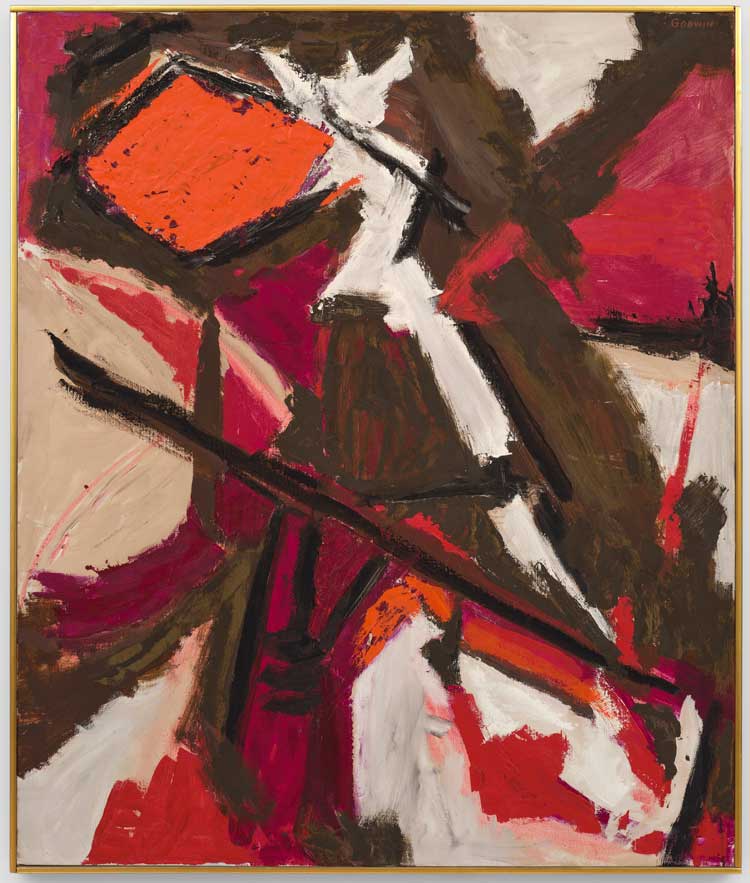
Judith Godwin. Elegy to a Slain Deer, 1975. Oil on canvas,
127 x 106.7 cm (50 x 42 in). Courtesy Pippy Houldsworth Gallery, London, and Berry Campbell, New York. © Judith Godwin Foundation. Photo: Ben Westoby.
Another important touchstone for Godwin was the Japanese abstract painter Kenzo Okada, the friend who introduced her to Zen Buddhism. From there, the writings of DT Suzuki led Godwin to find her own way of combining eastern and western thought in her painting. Her use of calligraphic brushwork within the field of abstract expressionist painting also evoked the iconography of Japanese gardens, and perhaps a reference back to her own interest in gardening and that of her father. In the much later work, To Kenzo (1982), a more muted modulated palette in earthy tones of brown, ochre and mustard emerges. With the appearance of an abstracted garden landscape viewed from above, the sections within the painting manifest paths, structures, drills and beds. There may be no sign of planting, but the ground has been prepared in readiness to nourish new growth.
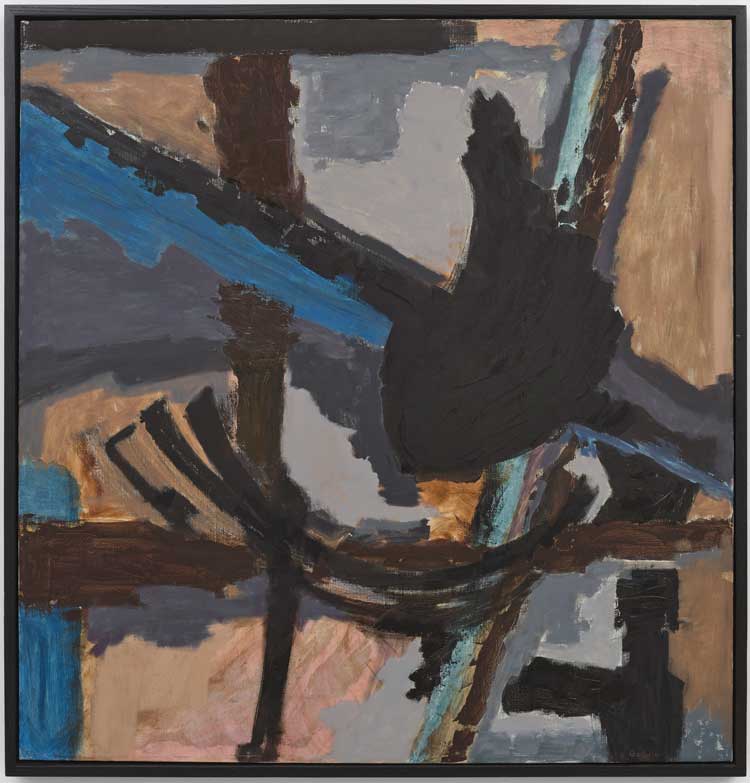
Judith Godwin. Betrayal, 1976. Oil on canvas, 127 x 121.9 cm (50 x 48 in). Courtesy Pippy Houldsworth Gallery, London, and Berry Campbell, New York. © Judith Godwin Foundation. Photo: Ben Westoby.
By the 60s, however, she established a studio in Connecticut and distanced herself from New York, looking to, among other things, Native American painting to expand her practice. The following decade, the 70s, is well represented in this exhibition with three paintings – Betrayal (1976), Elegy to a Slain Deer (1975) and Reflection (1979). The dark recesses and sober colours of Betrayal gesture to the moods and emotions of its title. Did Godwin feel betrayed by the art world, overlooked, or misunderstood? Maybe.
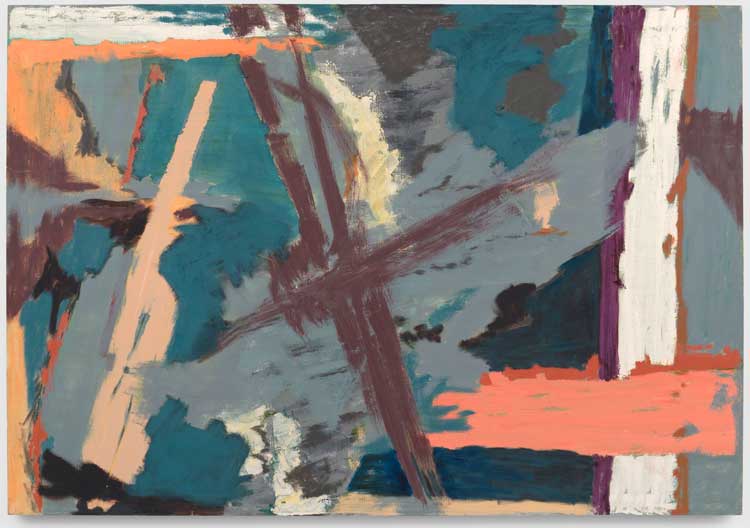
Judith Godwin. Reflection, 1979. Oil on canvas, 127 x 182.9 cm (50 x 72 in). Courtesy Pippy Houldsworth Gallery, London, and Berry Campbell, New York. © Judith Godwin Foundation. Photo: Ben Westoby.
Three years later in Reflection, her palette is softer and more muted. Still, the angles, energies and movement are no less dynamic. It is, in a sense, Godwin’s insistence on movement, inching abstract expressionism forward, and her disavowal of a naked, unmediated aggression in her painting that mark her out as a singular figure. Elegy to a Slain Deer is emblematic of this approach. For, despite the dominance of cadmium red and a definitive line of black paint slashed forcefully across the diagonal of the canvas, it is the elegiac that asserts itself in a composition where colour, line and form support one another to create a harmonious space for lamentation.
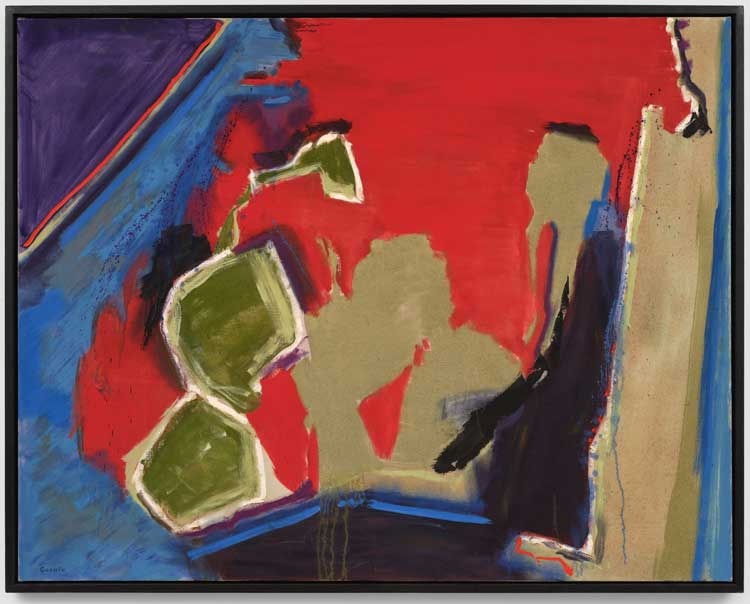
Judith Godwin. Green for Danger, 1982. Oil on canvas, 132.4 x 168 cm (52 1⁄8 x 66 1⁄8 in). Courtesy Pippy Houldsworth Gallery, London, and Berry Campbell, New York. © Judith Godwin Foundation. Photo: Ben Westoby.
Three later paintings in this exhibition – Green for Danger (1982), Ark (1983), and Planes (1991) – demonstrate something of the continuation of Godwin’s practice, but not sufficiently to get a real sense of what endured and what truly changed. Still, there is only so much you can achieve with a small group of works and those from the earlier decades weave a rich narrative of Godwin working within abstract expressionism and despite its strictures, conventions and biases. There is surely a great deal more to know and learn when it comes to Godwin.